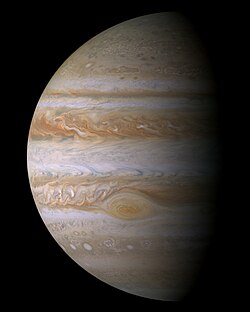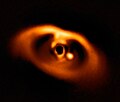Jupiter analogue

Jupiter analogues, also known as Jupiter-like planets, are exoplanets that are similar to the planet Jupiter, the fifth and largest planet in the solar system. They are often defined as planets that has at least 1 Jupiter mass or larger and orbits its host star at a distance 3 to 12 astronomical units (AU), roughly one to a few times that of the systems snow line. The lower limit of mass for Jupiter-like planets is not well defined as it can be as low of 0.8-0.3 Jupiter masses to include planets like Saturn.[1]
Formation and evolution
[edit]
While the exact formation of Jupiter-like exoplanets are not known,[2] models of gas giant planet formation predict that Jupiter-like planets should easily form around stars similar to our Sun through core-accretion mechanisms. This therefore should make planets similar to Jupiter a common occurrence in the universe with roughly 6-20% of Sun-like stars having Jupiter-like planets. But this number varies from low rates like 6.9% to higher rates like 25%.[1][clarification needed] It has been found that Jupiter analogues are very rare in mid to late type M-dwarf stars with 0.1-0.3 solar masses.[3]
The time it takes for form Jupiter-like planets is typically 3-5 million years but some estimates place the formation of Jupiter-like exoplanets to around 1-2 million years.[4]
Effect on their systems
[edit]
Jupiter has played a major role in the evolution of our Solar system, determining much of its structure and the configuration of solar system bodies. It is likely that Jupiter-like exoplanets play a similar role in their systems.[2]
Examples
[edit]
With their common occurrence and their increased chance of detection, there are many exoplanets that have been classed as Jupiter analogues.[citation needed]
Kepler-167e is a exoplanet orbiting the K-type main sequence star Kepler-167. It’s mass and radius is very similar to Jupiter with about 1 Jupiter masses and 0.9 Jupiter radii.[5]
References
[edit]- ^ a b Gratton, Raffaele; Mesa, Dino; Bonavita, Mariangela; Zurlo, Alice; Marino, Sebastian; Kervella, Pierre; Desidera, Silvano; D’Orazi, Valentina; Rigliaco, Elisabetta (2023-10-17). "Jupiter-like planets might be common in a low-density environment". Nature Communications. 14 (1): 6232. arXiv:2310.11190. Bibcode:2023NatCo..14.6232G. doi:10.1038/s41467-023-41665-0. ISSN 2041-1723.
- ^ a b Buchhave, Lars A.; Bitsch, Bertram; Johansen, Anders; Latham, David W.; Bizzarro, Martin; Bieryla, Allyson; Kipping, David M. (March 2018). "Jupiter Analogs Orbit Stars with an Average Metallicity Close to That of the Sun". The Astrophysical Journal. 856 (1): 37. arXiv:1802.06794. Bibcode:2018ApJ...856...37B. doi:10.3847/1538-4357/aaafca. ISSN 0004-637X.
- ^ Cowing, Keith (2023-06-14). "Mid-to-Late M Dwarfs Lack Jupiter Analogs". Astrobiology. Retrieved 2025-05-21.
- ^ Malewar, Amit (2025-03-06). "Gas giant exoplanets formed earlier than previously thought". Tech Explorist. Retrieved 2025-05-21.
- ^ Changeat, Quentin; Ikoma, Masahiro; Bocchieri, Andrea; Cassese, Ben; Edwards, Billy; Girard, Julien; Ito, Yuichi; Kimura, Tadahiro; Kipping, David Mathew; Ohno, Kazumasa; Pueyo, Laurent; Zak, Jiri (February 2024). "Contextualizing our solar-system: Atmospheric characterization of the Jupiter-analogue Kepler-167e". JWST Proposal. Cycle 3: 5531. Bibcode:2024jwst.prop.5531C.

